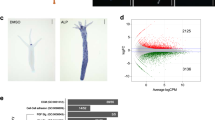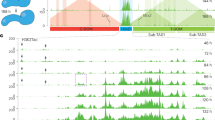Abstract
The anterior–posterior axis of the mouse embryo is established by two distinct organizing centres in the anterior visceral endoderm and the distal primitive streak1,2,3,4,5,6,7. These organizers induce and pattern the head and trunk respectively, and have been proposed to be localized through coordinate cell movements that rotate a pre-existing proximal–distal axis6,8. Here we show that correct localization of both head- and trunk-organizing centres requires Cripto9,10, a putative signalling molecule that is a member of the EGF-CFC gene family11,12. Before gastrulation, Cripto is asymmetrically expressed in a proximal–distal gradient in the epiblast, and subsequently is expressed in the primitive streak and newly formed embryonic mesoderm. A Cripto null mutation generated by targeted gene disruption results in homozygous Cripto−/− embryos that mostly consist of anterior neuroectoderm and lack posterior structures, thus resembling a head without a trunk. Notably, markers of the head organizer are located at the distal end of the embryo, whereas markers of the primitive streak are absent or localized to the proximal side. Our results indicate that Cripto signalling is essential for the conversion of a proximal–distal asymmetry into an orthogonal anterior–posterior axis.
This is a preview of subscription content, access via your institution
Access options
Subscribe to this journal
Receive 51 print issues and online access
$199.00 per year
only $3.90 per issue
Buy this article
- Purchase on Springer Link
- Instant access to full article PDF
Prices may be subject to local taxes which are calculated during checkout




Similar content being viewed by others
References
Thomas, P. & Beddington, R. S. P. Anterior primitive endoderm may be responsible for patterning the anterior neural plate in the mouse embryo. Curr. Biol. 6, 1487–1496 (1996).
Varlet, I., Collignon, J. & Robertson, E. J. nodal expression in the primitive endoderm is required for specification of the anterior axis during mouse gastrulation. Development 124, 1033–1044 (1997).
Belo, J. A. et al . Cerberus-like is a secreted factor with neutralizing activity expressed in the anterior primitive endoderm of the mouse gastrula. Mech. Dev. 68, 45–57 (1997).
Tam, P. P. & Behringer, R. R. Mouse gastrulation: the formation of a mammalian body plan. Mech. Dev. 68, 3–25 (1997).
Biben, C. et al . Murine cerberus homologue mCer-1: a candidate anterior patterning molecule. Dev. Biol. 194, 135–151 (1998).
Thomas, P. Q., Brown, A. & Beddington, R. S. P. Hex: homeobox gene revealing peri-implantation asymmetry in the mouse embryo and an early transient marker of endothelial cell precursors. Development 125, 85–94 (1998).
Waldrip, W. R., Bikoff, E. K., Hoodless, P. A., Wrana, J. L. & Robertson, E. J. Smad2 signaling in extraembryonic tissues determines anterior–posterior polarity of the early mouse embryo. Cell 92, 797–808 (1998).
Beddington, R. S. P. & Robertson, E. J. Anterior patterning in mouse. Trends Genet. 14, 277–284 (1998).
Dono, R. et al . The murine cripto gene: expression during mesoderm induction and early heart morphogenesis. Development 118, 1157–1168 (1993).
Johnson, S. E., Rothstein, J. L. & Knowles, B. B. Expression of epidermal growth factor family gene members in early mouse development. Dev. Dyn. 201, 216–226 (1994).
Shen, M. M., Wang, H. & Leder, P. Adifferential display strategy identifies Cryptic, a novel EGF-related gene expressed in the axial and lateral mesoderm during mouse gastrulation. Development 124, 429–442 (1997).
Zhang, J., Talbot, W. S. & Schier, A. F. Positional cloning identifies zebrafish one-eyed pinhead as a permissive EGF-related ligand required during gastrulation. Cell 92, 241–251 (1998).
Kinoshita, N., Minshull, J. & Kirschner, M. W. The identification of two novel ligands of the FGF receptor by a yeast screening method and their activity in Xenopus development. Cell 83, 621–630 (1995).
Xu, C., Liguori, G., Adamson, E. D. & Persico, M. G. Specific arrest of cardiogenesis in cultured embryonic stem cells lacking Cripto-1. Dev. Biol. 196, 237–247 (1998).
Candia, A. F. et al . Mox-1 and Mox-2 define a novel homeobox gene subfamily and are differentially expressed during early mesodermal patterning in mouse embryos. Development 116, 1123–1136 (1992).
Ang, S. L., Conlon, R. A., Jin, O. & Rossant, J. Positive and negative signals from mesoderm regulate the expression of mouse Otx2 in ectoderm explants. Development 120, 2979–2989 (1994).
Tao, W. & Lai, E. Telencephalon-restricted expression of BF-1, a new member of the HNF-3/fork head gene family, in the developing rat brain. Neuron 8, 957–966 (1992).
Crossley, P. H. & Martin, G. R. The mouse Fgf8 gene encodes a family of polypeptides and is expressed in regions that direct outgrowth and patterning in the developing embryo. Development 121, 439–451 (1995).
Hermesz, E., Mackem, S. & Mahon, K. A. Rpx: a novel anterior-restricted homeobox gene progressively activated in the prechordal plate, anterior neural plate and Rathke's pouch of the mouse embryo. Development 122, 41–52 (1996).
Muhr, J., Jessell, T. M. & Edlund, T. Assignment of early caudal identity to neural plate cells by a signal from caudal paraxial mesoderm. Neuron 19, 487–502 (1997).
Shawlot, W. & Behringer, R. R. Requirement for Lim1 in head-organizer function. Nature 374, 425–430 (1995).
Ang, S. L. et al . Atargeted mouse Otx2 mutation leads to severe defects in gastrulation and formation of axial mesoderm and to deletion of rostral brain Development 122, 243–252 (1996).
Rhinn, M. et al . Sequential roles for Otx2 in visceral endoderm and neuroectoderm for forebrain and midbrain induction and specification Development 125, 845–856 (1998).
Kannan, S. et al . Cripto enhances the tyrosine phosphorylation of Shc and activates mitogen-activated protein kinase (MAPK) in mammary epithelial cells J. Biol. Chem. 272, 3330–3335 (1997).
Liguori, G. et al . Characterization of the mouse Tdgf1 gene and Tdgf pseudogenes Mamm. Genome 7, 344–348 (1996).
Tybulewicz, V. L., Crawford, C. E., Jackson, P. K., Bronson, R. T. & Mulligan, R. C. Neonatal lethality and lymphopenia in mice with a homozygous disruption of the c-abl proto-oncogene Cell 65, 1153–1163 (1991).
Shalaby, F. et al . Failure of blood-island formation and vasculogenesis in Flk-1 deficient mice. Nature 376, 62–66 (1995).
Deng, C., Wynshaw-Boris, A., Zhou, F., Kuo, A. & Leder, P. Fibroblast growth factor receptor 3 is a negative regulator of bone growth Cell 84, 911–921 (1966).
Deng, C.-X. et al . Murine FGFR-1 is required for early postimplantation growth and axial organization Genes Dev. 8, 3045–3057 (1994).
Downs, K. M. & Davies, T. Staging of gastrulating mouse embryos by morphological landmarks in the dissecting microscope Development 118, 1255–1266 (1993).
Acknowledgements
We thank C. Abate-Shen, R. Beddington, R. Behringer, E. DeRobertis, A. Joyner, R.Krumlauf, E. Lai, G. Martin, A. McMahon, J. Rossant and C. Wright for gifts of probes and reagents; H.Wang and L. Garrett for technical assistance; and C. Abate-Shen, R. Steward, and members of M.M.S.'s laboratory for advice and comments on the manuscript. This work was supported by a postdoctoral fellowship from the American Heart Association (J.D.), and by grants from the American Heart Association, the U.S. Army Breast Cancer Research Program, and the NIH (to M.M.S.).
Author information
Authors and Affiliations
Corresponding author
Rights and permissions
About this article
Cite this article
Ding, J., Yang, L., Yan, YT. et al. Cripto is required for correct orientation of the anterior–posterior axis in the mouse embryo. Nature 395, 702–707 (1998). https://doi.org/10.1038/27215
Received:
Accepted:
Issue Date:
DOI: https://doi.org/10.1038/27215
This article is cited by
-
Regulatory changes associated with the head to trunk developmental transition
BMC Biology (2023)
-
Cripto-1 contributes to stemness in hepatocellular carcinoma by stabilizing Dishevelled-3 and activating Wnt/β-catenin pathway
Cell Death & Differentiation (2018)
-
The epigenetic modifier Fam208a is required to maintain epiblast cell fitness
Scientific Reports (2017)
-
Cripto is essential to capture mouse epiblast stem cell and human embryonic stem cell pluripotency
Nature Communications (2016)
-
Ectopic expression of Cripto-1 in transgenic mouse embryos causes hemorrhages, fatal cardiac defects and embryonic lethality
Scientific Reports (2016)
Comments
By submitting a comment you agree to abide by our Terms and Community Guidelines. If you find something abusive or that does not comply with our terms or guidelines please flag it as inappropriate.



